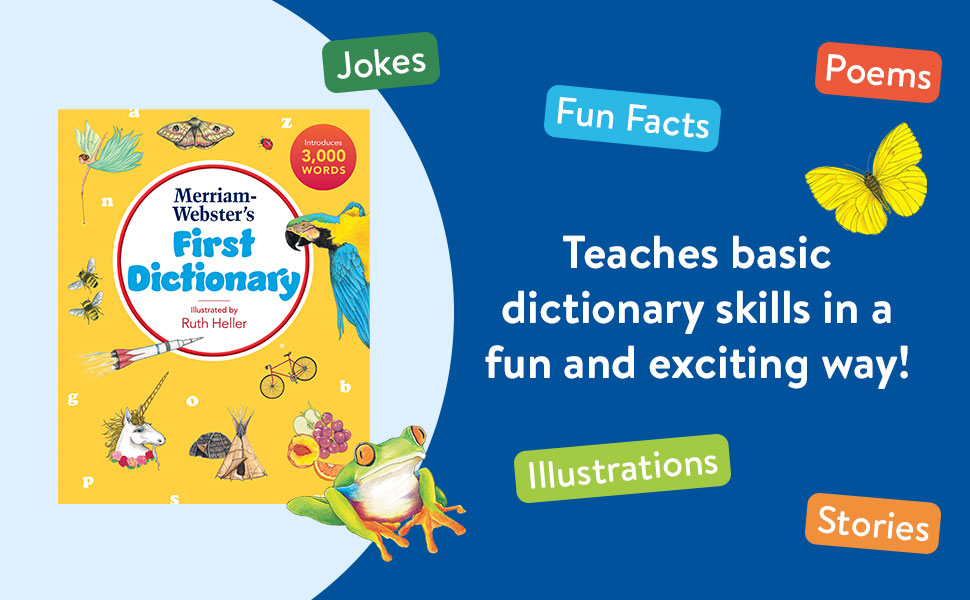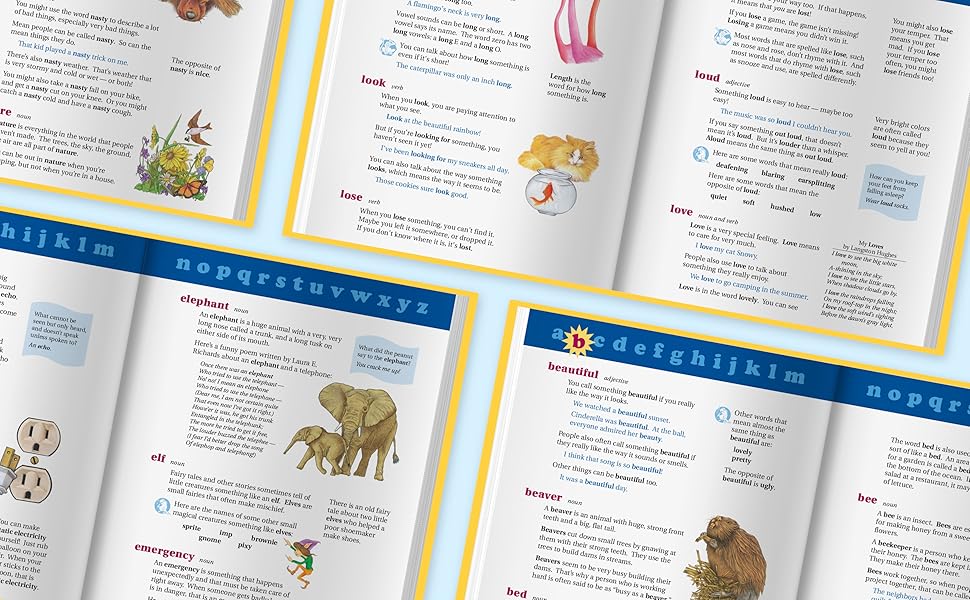







Full description not available



B**P
excellent reference resource for beginning readers
“Merriam-Webster’s First Dictionary,” compiled by the editors of Merriam-Webster Inc. and illustrated primarily by Ruth Heller, the popular author and illustrator of 23 fiction and nonfiction children’s books, is an excellent resource for children age five to seven. Conceived and executed specifically for beginning readers, this introductory reference features a “Preface” that explicates the premise of the work; an “Introduction to Teachers and Parents” that presents the work’s methodology; and “Here’s How to Use Your Dictionary,” which delineates the reference’s format and includes “Entry Blocks,” “Headwords,” “Word Functions,” “Related Words,” “Explanations,” “Example Sentences,” “Bonus Words,” “Word Histories,” “Stories,” “Poems,” “Head-Scratchers” (which provides “fun stuff about words”), “Look-It-Up Notes,” and “Jokes” (such as riddles and knock-knock jokes). Large-font alphabetic page headers that identify the first letter of the words included on that page and “Page Turn” symbols which indicate that entry blocks continue onto the next page provide clear visual directions for utilizing the dictionary. An entry block for each letter features a poem that outlines the sound(s) of the initial letters included in that section of the dictionary using sample words. Unfortunately, however, there is neither a pronunciation guide nor pronunciation symbols to facilitate learning word sounds. The parts of speech (noun, verb, adjective, adverb, interjection), however, for each word are clearly listed. Another criticism is that some words known and/or used by children are omitted from the dictionary. “Meow” and “cat,” for example, are included as is “dog,” but “woof” is omitted. A profusion of beautiful, vivid, full-color illustrations enhances the definitions and font color differentiation is used throughout the dictionary to distinguish categories of text. The dictionary concludes with sections on “words to help you with spelling” that includes “in-between words” (such as “about,” “against,” “because”), “words that point,” (such as “her,” “his,” “mine,” “their,” “which,” “who,” “you”), “Words about being and doing” (such as “are,” “be,” “been,” “could,” “might,” “should,” “would”) and “Numbers” that are listed numerically and in words. “More Spelling Words” includes “again,” “count,” “many,” “often,” “there,” “too,” “what,” “when,” “where,” and “why” among others and “Word Functions” explicates various parts of speech. Finally, “Timeline” features word etymology. Criticisms notwithstanding, this juvenile resource is admirably conceived, organized, delineated, and produced and is sure to appeal to youngsters and parents alike. The sturdy construction and heavy paper will withstand continuous use, the large format (8 and 3/4” x 11” x 7/8”) will be easy for small hands to hold, and the reasonable price is a bargain. This is a highly recommended resource, especially since most children’s dictionaries are intended for older readers.
M**E
Happy children
It's a beautiful dictionary with pictures and useful grammar education other than just definitions. I gave it as a gift for Summer reading. The children were delighted with all the information in it. I am so happy!
G**R
Hard cover first dictionary
Good for a curious child. Perfect for an early reader to expand their vocabulary.
A**R
Overall good for 7yr old
Bought for my 7yr old so they could try and find spellings on their own. It is helpful and has allowed for some more independents with writing projects.
C**E
Dictionary
My niece enjoy this dictionary! There is some many words to learn from
L**A
Great resource
Great for child's first library
L**Z
quality
very nice thank you!
L**A
Diccionario
Mi hijo está aprovechando mucho si diccionario con illustrationciones y todo muy lindo y útil
Trustpilot
5 days ago
3 days ago